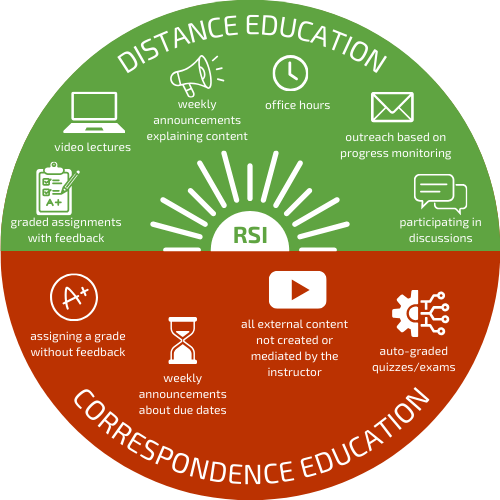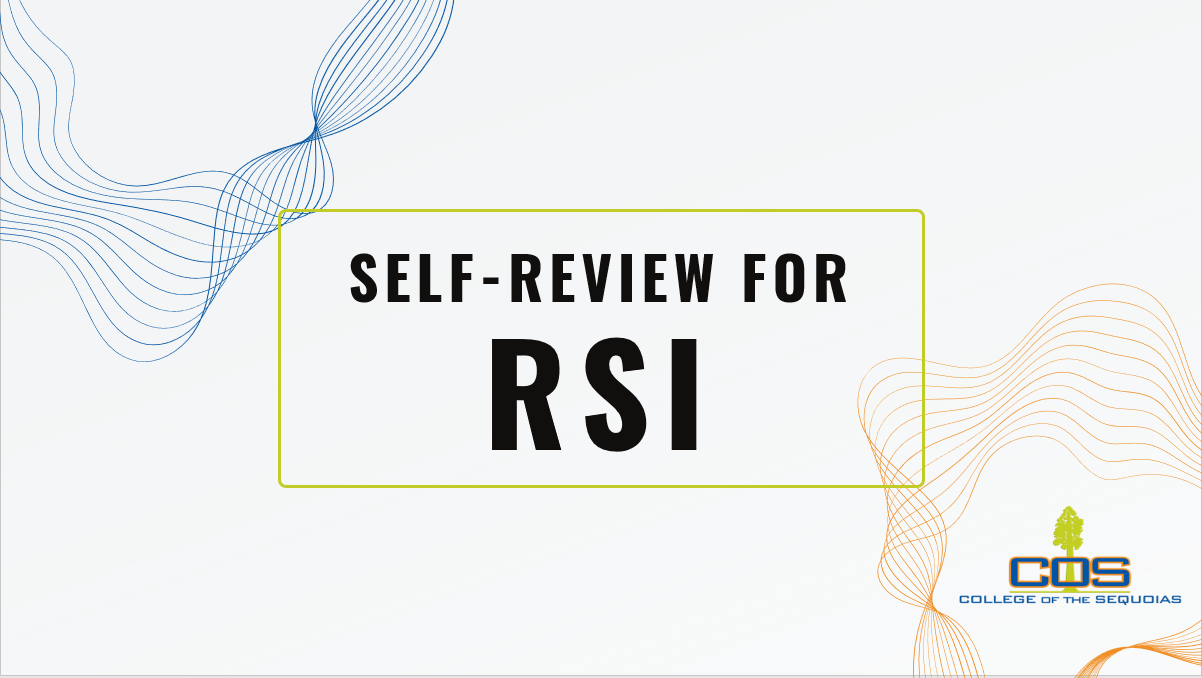Regular-and-Substantive-Interaction-(RSI)-Training-and-Resources|b9e086ab-42e6-483b-aed4-b6c49fec34e6
Regular-and-Substantive-Interaction-(RSI)-Training-and-Resources
Content Editor
What is RSI?
RSI stands for
Regular and
Substantive
Interaction, and refers to the frequency and quality of instructor-student interactions in fully-online courses. It is the responsibility of every online instructor to meet RSI requirements for each online course that they teach. They may do so themselves or with the help of
a another instructor, instructional
support staff, or their dean.
REGULAR
|
SUBSTANTIVE
|
INTERACTION
|
|
FREQUENTLY AND CONSISTENTLY
THROUGHOUT THE COURSE
-
PROMPT
-
PREDICTABLE
-
PROACTIVE
-
POLICIES
|
ACADEMIC IN NATURE, AND RELEVANT
TO THE CONTENT OF THE COURSE
-
SYNCHRONOUS PRESENCE
-
FORMATIVE NON-AUTOMATED FEEDBACK
-
INSTRUCTOR-CREATED/MEDIATED CONTENT
-
RESPONDING TO QUESTIONS
-
FACILITATING DISCUSSION
-
“OTHER”
|
COMMUNICATION WITH AND BETWEEN STUDENTS, INITIATED BY THE INSTRUCTOR
-
FACULTY-TO-STUDENT
-
STUDENT-TO-STUDENT
|
Why do we need to do RSI?
RSI is not optional, nor is it an issue of academic freedom. Faculty who teach online are required by law to interact regularly with their students about the content of the course they are teaching, and colleges are required to ensure RSI is occuring by monitoring online instruction. How that occurs is left up to colleges.
2. decades of research connect it to student success.
RSI is nothing new - it is simply a new name for a set of pedagogical best practices that are widely accepted across every teaching modality. Decades of research have shown that student engagement and interaction in online courses are essential to student success. RSI has
always been a key component of online certifications.
Though it may be tempting to think of RSI as an additional burden imposed on an already full faculty workload, ensuring that regular and substantive interaction occurs in all online courses aligns with our vision of ensuring students achieve their full education potential regardless of learning modality.
3. it enables us to receive federal financial aid.
Regular, substantive interaction is what sets
distance education apart from
correspondence education.
Correspondence education is characterized by student submissions and assignment of grades, while distance education is characterized by the rich interaction students and teachers have in the online space. Students cannot receive financial aid for correspondence courses.
There have been cases where the Department of Education has sought hundreds of millions of dollars in financial aid reimbursements from colleges and universities when it was discovered that courses designated as distance education were actuall being taught in a correspondence format.

4. there are serious consequences if online courses do not meet the mandate for rsi.
Institutional compliance is required and non-compliance can have a variety of consequences, including:
-
University fines
-
Individual disciplinary action for faculty and or staff
-
Loss of the: ability to award federal financial aid to students
-
Ability to serve U.S. military, veteran, or dependent students
-
Ability to offer online education
-
Ability to approve new courses and or programs
It turns out, these aren't empty or idle threats:
Simply put, to offer courses online, RSI is required.
What will a course reviewer be looking for in my online course?
The Accrediting Commision for Community and Junior Colleges (ACCJC) has created
The Quality Continuum Rubric for Distance Education to answer that very question. It details four categories of Substantive interaction and two categories of Regular interaction, providing insight into how RSI can be implemented in ways that support both our students and our accreditation.
How do I make sure I'm doing RSI?
For starters, the Distance Education Coordinator has also broken the ACCJC rubric into "bite-size" pieces with ideas for implementing each of them into online courses. If you incorporate the ideas and suggestions provided in these training documents, you will have be doing RSI in multiple, meaningful ways throughout your course.
#2:
Provide Meaningful Feedback on Assignments, AKA not just a grade (PDF)
#3:
Using Announcements (PDF)
#4:
Facilitating Discussions (PDF)
#5:
Providing and Mediating Instructional Content, AKA teaching the class (PDF)
#6:
Monitoring Student Engagement and Success (PDF)
#7:
Third-Party Instructional Software and Platforms (PDF)
#8:
Make it Visible
Additionally, you can self-review for RSI using the slides below, from the Spring through Fall 2024 Self-Review for RSI Workshop series.
Click the image below to download the slides:

Additional Training and Resources
A straight-forward list that clarifies what type of interactions do and do not qualify as RSI.
-
CVC @ONE Webinar Series: Regular Substantive Interaction:
Delve into the core of Regular Substantive Interaction (RSI), understanding what it is and why it matters. This webinar series offers RSI engagement strategies, tools to enhance RSI, and how RSI fosters equity and inclusion. Participants will learn how to elevate their engagement with students to cultivate a culture of meaningful connection and interaction.
This webinar will review RSI definitions and regulations and share strategies that ensure courses meet these regulations. In July 2021, the U.S. Department of Education (DOE) adopted RSI to ensure that online courses remain eligible for federal finance aid and differ significantly from correspondence courses. Online courses must now have predictable and scheduled interaction that meet specific criteria. Presenter DeAnna Gossett will review strategies that will not only help participants comply with RSI, but also build a more interactive learning experience for students!
Building a culture of feedback in the online modality is essential for student success. Gathering this valuable information can be done in a few easy ways with some planning and execution. We will look at empowering students through self-assessments, capturing timely informal feedback and designing effective course surveys. Participants will leave the webinar with hands-on strategies that may implement in their online courses.
